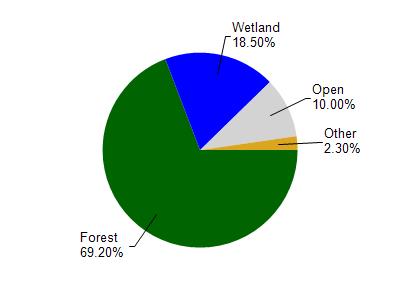Vilas
No
Yes
No
Fish and Aquatic Life
Overview
Black Oak Lake, in the Tamarack Pioneer River Watershed, is a 563.80 acre lake that falls in Vilas County. This lake is an outstanding/exceptional resource water under NR102 under the Fisheries Program. This lake is managed for fishing and swimming and is currently not considered impaired.
Date 2011
Author Aquatic Biologist
Historical Description
Source: 1963, Surface Water Resources of Vilas County Oak (Black)Lake, T-43-N, R-9-E, Sections 30 and 31, 35 and 36, Area = 59 Surface Acres, Maximum Depth = 63 feet, S.D.F. = 2.13.
Black Oak Lake is a drainage lake of moderate fertility. It has slightly alkaline, clear water of high transparency. The bottom material consists mostly of sand and gravel, with rock and some muck. Neither the inlet or the outlet stream is considered to be navigable. A variety of fish species are present in the lake including muskellunge, northern pike, walleye, largemouth bass, smallmouth bass and pan fish. Two species of trout, the lake trout and the rainbow trout, and cisco are also present. Basic management of this water is directed toward lake trout and walleye. There is public access by means of the county park area which provides both picnic facilities and boat launching area. Public use facilities consist of six resorts with three boat rental facilities. There are 94 cottages located on or about the shore.
Date 1963
Author Surface Water Inventory Of Wisconsin
General Condition
Black Oak Lake Beach was assessed for the 2018 listing cycle; E. coli data sample data were clearly below the 2018 WisCALM listing thresholds for the Recreation use. This beach was meeting this designated use and was not considered impaired.
Date 2017
Author Ashley Beranek
General Condition
Black Oak Lake (1630100) was assessed during the 2016 listing cycle; total phosphorus and chlorophyll sample data were clearly below 2016 WisCALM listing thresholds for the Recreation use and Fish and Aquatic Life use. This water is meeting these designated uses and is not considered impaired.
Date 2015
Author Ashley Beranek
Condition
Wisconsin has over 84,000 miles of streams, 15,000 lakes and milllions of acres of wetlands. Assessing the condition of this vast amount of water is challenging. The state's water monitoring program uses a media-based, cross-program approach to analyze water condition. An updated monitoring strategy (2015-2020) is now available. Compliance with Clean Water Act fishable, swimmable standards are located in the Executive Summary of Water Condition in 2018. See also the 'monitoring and projects' tab.
Reports
Recommendations
Develop/Distribute Brochures/Literature
Monitor Invasive Species
Watercraft Inspections Clean Boats, Clean Waters
Lake Management Plan Development
update
Monitor Water Quality or Sediment
Lakes Planning Grant
Aquatic Plant Monitoring or Survey
Habitat Restoration - Shoreland
Shoreland Restoration
Information and Education
Hire Local Aquatic Invasives Coordinator
Monitor Water Quality or Sediment
Lake Management Plan Development
Management Goals
Wisconsin's Water Quality Standards provide qualitative and quantitative goals for waters that are protective of Fishable, Swimmable conditions [Learn more]. Waters that do not meet water quality standards are considered impaired and restoration actions are planned and carried out until the water is once again fishable and swimmable
Management goals can include creation or implementation of a Total Maximum Daily Load analysis, a Nine Key Element Plan, or other restoration work, education and outreach and more. If specific recommendations exist for this water, they will be displayed below online.
Monitoring
Monitoring the condition of a river, stream, or lake includes gathering physical, chemical, biological, and habitat data. Comprehensive studies often gather all these parameters in great detail, while lighter assessment events will involve sampling physical, chemical and biological data such as macroinvertebrates. Aquatic macroinvertebrates and fish communities integrate watershed or catchment condition, providing great insight into overall ecosystem health. Chemical and habitat parameters tell researchers more about human induced problems including contaminated runoff, point source dischargers, or habitat issues that foster or limit the potential of aquatic communities to thrive in a given area. Wisconsin's Water Monitoring Strategy was recenty updated.
Grants and Management Projects
Monitoring Projects
| WBIC | Official Waterbody Name | Station ID | Station Name | Earliest Fieldwork Date | Latest Fieldwork Date | View Station | View Data |
|---|
| 1630100 | Black Oak Lake | 643126 | Black Oak Lake - Deep Hole | 8/8/1973 | 8/21/2025 | Map | Data |
| 1630100 | Black Oak Lake | 10039813 | Black Oak Lake Beach | 7/21/2008 | 8/4/2025 | Map | Data |
| 1630100 | Black Oak Lake | 10018650 | Black Oak Lake -- Boat Launch - Cth B Nr George Lk | 5/19/2007 | 10/19/2025 | Map | Data |
| 1630100 | Black Oak Lake | 10005961 | Black Oak Lake | 5/10/1909 | 4/14/2024 | Map | Data |
| 1630100 | Black Oak Lake | 643600 | Black Oak Lake - North Shore - Trout | | | Map | Data |
|

Watershed Characteristics
Black Oak Lake is located in the Tamarack Pioneer River watershed which is 209.26 mi². Land use in the watershed is primarily forest (69.20%), wetland (18.50%) and a mix of open (10%) and other uses (2.30%). This watershed has 183.22 stream miles, 14,006.68 lake acres and 23,826.05 wetland acres.
Nonpoint Source Characteristics
This watershed is ranked Low for runoff impacts on streams, Medium for runoff impacts on lakes and Low for runoff impacts on groundwater and therefore has an overall rank of Low. This value can be used in ranking the watershed or individual waterbodies for grant funding under state and county programs.However, all waters are affected by diffuse pollutant sources regardless of initial water quality. Applications for specific runoff projects under state or county grant programs may be pursued. For more information, go to surface water program grants.